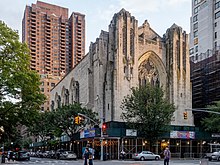
Chartres Cathedral, also known as the Cathedral of Our Lady of Chartres, is a Catholic church in Chartres, France, about 80 km southwest of Paris, and is the seat of the Bishop of Chartres. Mostly constructed between 1194 and 1220, it stands on the site of at least five cathedrals that have occupied the site since the Diocese of Chartres was formed as an episcopal see in the 4th century. It is one of the best-known and most influential examples of High Gothic and Classic Gothic architecture, It stands on Romanesque basements, while its north spire is more recent (1507–1513) and is built in the more ornate Flamboyant style.

Lee Oscar Lawrie was an American architectural sculptor and an important figure in the American sculpture scene preceding World War II. Over his long career of more than 300 commissions Lawrie's style evolved through Modern Gothic, to Beaux-Arts, Classicism, and, finally, into Moderne or Art Deco.

Cathedrals, collegiate churches, and monastic churches like those of abbeys and priories, often have certain complex structural forms that are found less often in parish churches. They also tend to display a higher level of contemporary architectural style and the work of accomplished craftsmen, and occupy a status both ecclesiastical and social that an ordinary parish church rarely has. Such churches are generally among the finest buildings locally and a source of regional pride. Many are among the world's most renowned works of architecture. These include St Peter's Basilica, Notre-Dame de Paris, Cologne Cathedral, Salisbury Cathedral, Antwerp Cathedral, Prague Cathedral, Lincoln Cathedral, the Basilica of Saint-Denis, Santa Maria Maggiore, the Basilica of San Vitale, St Mark's Basilica, Westminster Abbey, Saint Basil's Cathedral, Antoni Gaudí's incomplete Sagrada Família and the ancient cathedral of Hagia Sophia in Istanbul, now a mosque.

Ralph Adams Cram was a prolific and influential American architect of collegiate and ecclesiastical buildings, often in the Gothic Revival style. Cram & Ferguson and Cram, Goodhue & Ferguson are partnerships in which he worked. Cram was a fellow of the American Institute of Architects.

Saint Thomas Church is an Episcopal parish church of the Episcopal Diocese of New York at 53rd Street and Fifth Avenue in Midtown Manhattan, New York City. Also known as Saint Thomas Church Fifth Avenue or Saint Thomas Church in the City of New York, the parish was incorporated on January 9, 1824. The current structure, the congregation's fourth church, was designed by the architects Ralph Adams Cram and Bertram Grosvenor Goodhue in the French High Gothic Revival style and completed in 1914. In 2021, it reported 2,852 members, average in-person attendance of 224 and $1,152,588 in plate and pledge income.

The Metropolitan Cathedral of Saints Vitus, Wenceslaus and Adalbert is a Catholic metropolitan cathedral in Prague, and the seat of the Archbishop of Prague. Until 1997, the cathedral was dedicated only to Saint Vitus, and is still commonly named only as St. Vitus Cathedral.
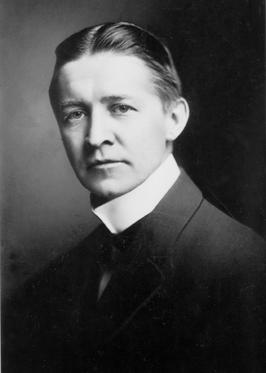
Bertram Grosvenor Goodhue was an American architect celebrated for his work in Gothic Revival and Spanish Colonial Revival design. He also designed notable typefaces, including Cheltenham and Merrymount for the Merrymount Press. Later in life, Goodhue freed his architectural style with works like El Fureidis in Montecito, California, one of three estates he designed.
Mayers, Murray & Phillip was an architecture firm in New York city and the successor firm to Goodhue Associates, after Bertram Goodhue's unexpected death in 1924. The principals were Francis L.S. Mayers,Oscar Harold Murray, and Hardie Phillip.

St. Bartholomew's Church, commonly called St. Bart's, is a historic Episcopal parish founded in January 1835, and located on the east side of Park Avenue between 50th and 51st Street in Midtown Manhattan, in New York City. In 2018, the church celebrated the centennial of its first service in its Park Avenue home.

The Church of Saint-Germain-des-Prés is a Roman Catholic parish church located in the Saint-Germain-des-Prés quarter of Paris. It was originally the church of a Benedictine abbey founded in 558 by Childebert I, the son of Clovis, King of the Franks. It was destroyed by the Vikings, rebuilt, and renamed in the 8th century for Saint Germain, a 6th century bishop. It was rebuilt with elements in the new Gothic style in the 11th century, and was given the first flying buttresses in the 12th century. It is considered the oldest existing church in Paris.

The Church of Saint-Germain l'Auxerrois is a medieval Roman Catholic church in the 1st arrondissement of Paris, directly across from the Louvre Palace. It was named for Saint Germanus of Auxerre, a medieval bishop of Auxerre, who became a papal envoy and met Saint Genevieve, the patron saint of Paris, on his journeys. Genevieve is reputed to have converted queen Clotilde and her husband, French king Clovis I to Christianity at the tomb of Saint Germain in Auxerre.
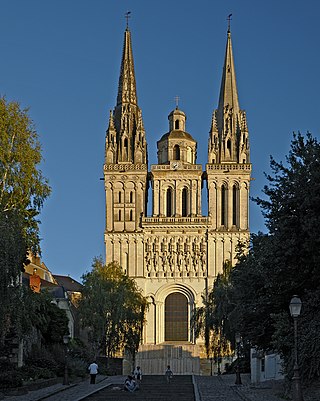
Angers Cathedral is a Catholic church dedicated to Saint Maurice in Angers, France. It is the seat of the Bishops of Angers.

Bordeaux Cathedral, officially known as the Primatial Cathedral of St Andrew of Bordeaux, is a Catholic church dedicated to Saint Andrew and located in Bordeaux, France. It is the seat of the Archbishop of Bordeaux.
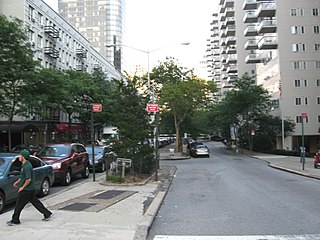
66th Street is a crosstown street in the New York City borough of Manhattan with portions on the Upper East Side and Upper West Side connected across Central Park via the 66th Street transverse. West 66th Street is notable for hosting the Lincoln Center for the Performing Arts between Broadway and Columbus Avenue.

The Church of Saint-Merri or Église Saint-Merry) is a parish church in Paris, located near the Centre Pompidou along the rue Saint Martin, in the 4th arrondissement on the Rive Droite. It is dedicated to the 8th century abbot of Autun Abbey, Saint Mederic, who came to Paris on pilgrimage and later died there in the year 700. In 884 Mederic was declared patron saint of the Right Bank.

The Church of St. Vincent Ferrer is a Catholic parish in the Upper East Side of Manhattan, New York City. It was built in 1918 by the Dominicans; the attached priory serves as the headquarters of the Eastern United States Province of the order. Its architecture has some unusual features: above the front entrance is one of the few statues of the Crucifixion on the exterior of an American Catholic church; and inside, the Stations of the Cross depict Christ with oil paintings instead of statuary or carvings. It has two Schantz pipe organs. The church building, at the corner of Lexington Avenue and East 66th Street in the Lenox Hill section of the Upper East Side, has been called "one of New York's greatest architectural adornments."
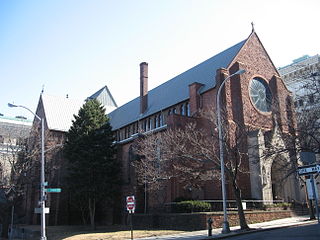
The Cathedral of All Saints, Albany, New York, is located on Elk Street in central Albany, New York, United States. It is the central church of the Episcopal Diocese of Albany and the seat of the Episcopal Bishop of Albany. Built in the 1880s in the Gothic style and designed by Robert W. Gibson, it was listed on the National Register of Historic Places in 1974. Previously it had been recognized as a contributing property to the Lafayette Park Historic District, listed on the Register in 1970.
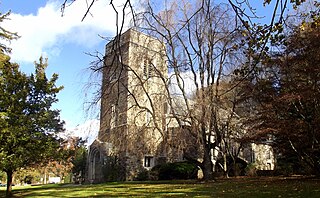
St. Mark's Episcopal Church is a historic Episcopal church at the junction of N. Bedford Rd. and E. Main Street in Mt. Kisco, Westchester County, New York. It was designed by architect Bertram Goodhue in 1907 and built from 1909 to 1913 in the late Gothic Revival style. The church was expanded in 1927–1928. It is a two-story building constructed of square cut local granite and schist. It has carved limestone trim and copings and a statue of St. Mark by Lee Lawrie. Its intersecting gable roof is covered by green and purple slate shingles. A tower was added in 1919–1920. Connected to the church is a contributing parish hall.

The Cathedral of Saint Peter of Alcantara, also known as the Cathedral of Petrópolis, is a Roman Catholic cathedral in Petrópolis, Brazil, dedicated to the city's patron saint, Peter of Alcantara. The cathedral is also the final resting place of the last Emperor of Brazil, Dom Pedro II, and his family.

Gothic cathedrals and churches are religious buildings created in Europe between the mid-12th century and the beginning of the 16th century. The cathedrals are notable particularly for their great height and their extensive use of stained glass to fill the interiors with light. They were the tallest and largest buildings of their time and the most prominent examples of Gothic architecture. The appearance of the Gothic cathedral was not only a revolution in architecture; it also introduced new forms in decoration, sculpture, and art.
